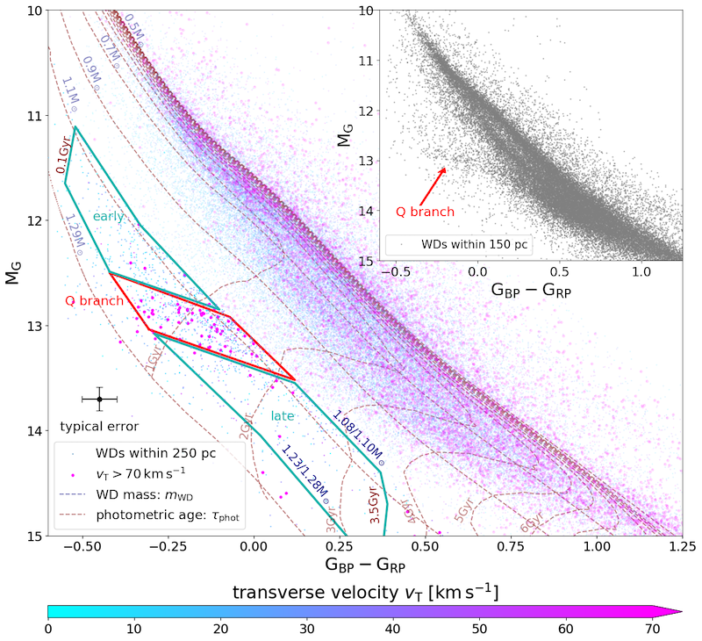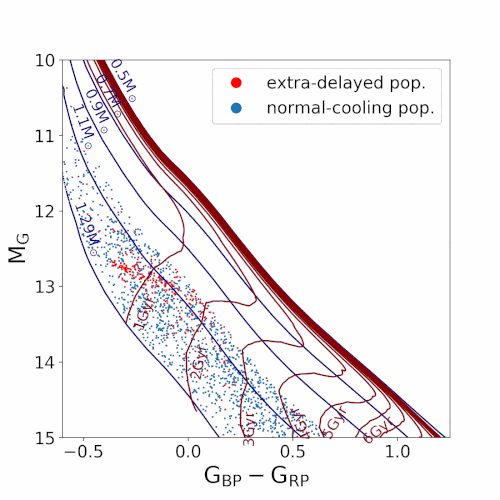Editor’s note: Astrobites is a graduate-student-run organization that digests astrophysical literature for undergraduate students. As part of the partnership between the AAS and astrobites, we occasionally repost astrobites content here at AAS Nova. We hope you enjoy this post from astrobites; the original can be viewed at astrobites.org.
Title: A Cooling Anomaly of High-Mass White Dwarfs
Authors: Sihao Cheng (程思浩), Jeffrey D. Cummings, and Brice Ménard
First Author’s Institution: The Johns Hopkins University
Status: Accepted to ApJ
The European Space Agency’s Gaia mission has revolutionized astronomy, and it will continue to do so as its mission progresses. Pristine color–magnitude (or Hertzsprung-Russell) diagrams can be made with the extremely precise distances the mission provides, uncovering new features. Today’s paper focuses on explaining some interesting features discovered in the white dwarf sequence seen in Gaia’s second data release (GDR2).
White dwarfs are the end state of most stars. After evolving off the main sequence, low mass stars shed their outer layers, leaving behind an extremely hot core of (in most cases) carbon and oxygen. At this point, the white dwarf will cool off forever. GDR2 revealed some interesting structure in this cooling sequence, including evidence of double white dwarf mergers and a splitting of hydrogen-atmosphere white dwarfs (“DAs”, in the A branch) from those with helium atmospheres (“DBs”, in the B branch). In this context, a branch is a concentration of stars off of the main sequence that stars evolve along or through. A third and less understood branch was found to contain “DQ” white dwarfs, which show carbon in their atmospheres; this was named the Q branch. The GDR2 white dwarf cooling sequence is shown in Figure 1.

Figure 1: The HR diagram of white dwarfs selected from GDR2 for this work. Model ages and masses are indicated by dashed lines. Color indicates the velocity of each star. The Q branch is indicated by the red arrow in the inset and outlined in the main figure. [Cheng et al. 2019]
To test this hypothesis, the authors ran a statistical model of white dwarf evolution. The model includes double white dwarf mergers (which also produce a discrepancy between velocity photometric ages), tracks the ages and velocities of the stars, and tries to match the observations. The parameters of interest for the cooling hypothesis are the fraction of stars that undergo a cooling delay and the length of that delay. After examining many other parameters (see section 4 of the paper for all the gory details), the authors show that 6% of high-mass white dwarfs appear to experience an 8-billion-year delay of cooling as they evolve along the Q branch. Since this delay causes a pile-up, about half of white dwarfs on the Q branch are delayed. The authors also constrain the double-white dwarf merger fraction to about 22% of massive white dwarfs. Figure 2 shows the HR diagram produced by the simulation.

Figure 2: HR diagram showing the two populations of white dwarfs evolving down the cooling sequence over time. Each second corresponds to 1 Gyr. [Sihao Cheng et al.]

Figure 3: The effective zone of 22Ne settling for two different abundances of 22Ne. The cooling delay happens when the luminosity of 22Ne settling is similar to the surface luminosity. This region is narrow and matches the position and shape of the Q branch quite well. [Cheng et al. 2019]
About the author, Samuel Factor:
Sam Factor is a 5th year Ph.D. candidate at The University of Texas at Austin studying direct imaging of extrasolar planets and low mass binary stars. He uses an interferometric post processing technique to allow the detection of companions below the diffraction limit of the telescope.
